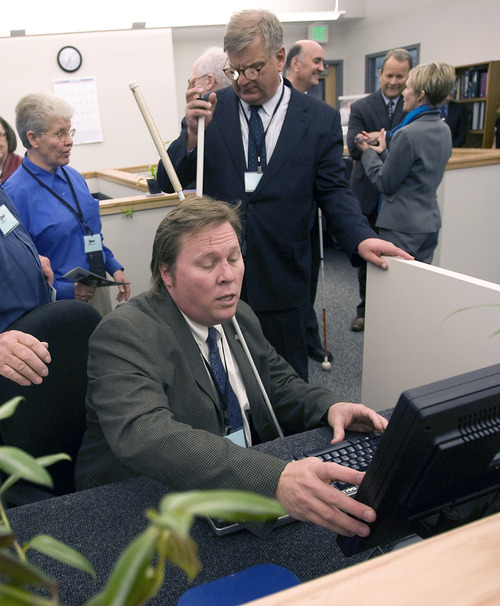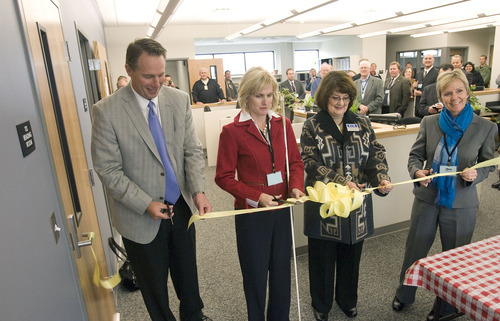This is an archived article that was published on sltrib.com in 2011, and information in the article may be outdated. It is provided only for personal research purposes and may not be reprinted.
Draper • When Jeff Smith listens to the soft, tenor voice of Tom Black reading the biography of LDS President Thomas S. Monson, it's easy for him to lose himself in the inspirational words and pictures the story paints in his mind.
It's easy to forget he's listening to the voice of one of the most dislikable men in the state.
"He reads with feeling and with the emphasis in all the right places," Smith said. "With a good reader, you forget about the reader and listen instead to the message of the book. That's what it's like listening to Tom Black."
But Black isn't your typical reader of books on tape. He's an inmate at the Utah State Prison, serving 10 years to life for sexually abusing a child.
When Smith stops his audio book, he does wonder about Black, about who he is and why he can't return to a family at night after a day of recording.
"I marvel at that. I wonder what they've done to be put in there," Smith said. "These guys provide this great service, but they're in prison."
The 57-year-old Smith, who fully lost his vision about 10 years ago to a genetic, degenerative eye disease, has listened to books on tape from the Utah State Library for the Blind and Disabled for the past 15 years. Black has read at least a dozen inspirational LDS books to Smith and scores of other library patrons, including the Monson biography To the Rescue by Heidi Swinton.
Black is one of 25 inmates who work at the state library's Reading for the Blind program at the prison, which records anywhere between 15 and 25 books a month for blind or disabled library patrons.
On Tuesday, Smith and Black were able to meet. Smith was curious about who Black was. As a member of The Church of Jesus Christ of Latter-day Saints, Smith wonders if Black has picked up some of the same spiritual lessons and gospel teachings he has.
"I told him how much I appreciated what he does for us," Smith said. "I wanted to know what a difference he was making for those of us who are blind."
Smith said that Black told him he was grateful for the opportunity to give back to the community.
The program at the prison, which is a collaboration between the Utah Department of Corrections and the Utah Department of Community and Culture's State Library, mostly records books that are not recorded by any other federal, or often commercial, entity, said state librarian Donna Jones Morris. It serves Utahns, and blind and disabled people throughout the country. More than 9,000 people are served in Utah alone, with several thousand in surrounding states.
It's a program that helps both the blind in the community at large and inmates at the prison, said Tom Patterson, executive director of the Department of Corrections.
"Works that touch the soul and reach the human heart are priceless," Patterson said. "If you put yourself in the place of one of these inmates in this program, think of the benefit that comes to them. Not only do they provide a service, but they're finding what impacts their own souls."
Bret Lindeman, who killed his wife in 1999, has worked as a clerk for the program for the past two years. In his 40 hours per week at the program, he assigns books to readers, coordinates the editing process and oversees the duplication of books.
"So many negative things brought us in here, and it's our choice to follow whatever path we want, and this lets us go down the path of giving back," said Lindeman, who could spend up to life in prison. "It gives us a place where we're not in the same turmoil every day and provides a positive work environment."
The inmates who work in the program are paid between 40 and 60 cents an hour, one of the lowest-paying jobs at the prison, said Tyler Limb, a Corrections officer who supervises the program. The inmates who work there must first obtain the highest privilege level at the prison through good behavior and be skilled; and while not a requirement, they are often highly educated.
Of those who record the books, about 60 percent are sex offenders and 40 percent are murderers. In the three years Limb has monitored the program, he has never had to discipline one of the inmates working in the program, he said.
In July, a new building that was funded solely with community donations opened at the prison. The prison will pay for the nominal ongoing costs, such as electricity and heat.The new building has eight sound-proofed recording booths and allowed the program to expand from 17 inmates to 25, meaning more books can be recorded each week. If the view from the window weren't of chain-linked fence and barbed wire, those inside would think they're in any other office setting, replete with small potted plants and black, rolling desk chairs.
On Tuesday, the prison invited government officials and patrons from the library for the blind and disabled to a ribbon-cutting ceremony.
Twitter: @sheena5427 —
Listening Titles at the State Library for the Blind and Disabled
LDS nonfiction
Articles of Faith by James Talmage
Stories from the Life of Porter Rockwell by John W. Rockwell
Divine Signature by Gerald Lund
LDS fiction
Lemon Tart by Josi S. Kilpack
Murder by the Book by Betsy Brannon Green
Best of Times by Anita Stansfield
Local history/biography
Madam Chair by Jean Westwood
History of Salt Lake County
Proper Edge of the Sky by Edward A. Geary
Local recreation
Utah: Best Tent Camping
Backroads of Utah by Theresa Husarik
Ron Kay's Guide to Zion's National Park
Local authors
One Foot in the Grave by Chad Daybell
Evolution of Thomas Hall by Keith Merrill
Hearing with my Heart by Justin Osmond
Hourglass Door by Lisa Mangum
Patron requests
Wyoming Range War by John W. Davis
Cedar Post by Jack R. Rose
Rocks Begin to Speak by La Van Martineau
People-Reading by Ernst G. Beier







